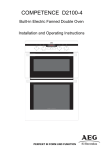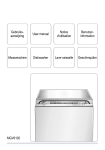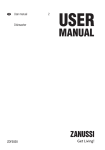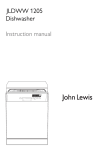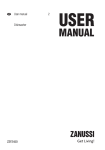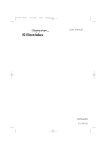Download AEG F 89020 VI Dishwasher User Guide Manual Operating
Transcript
FAVORIT 89020 I
User manual
Downloaded from DishWasher-Manual.com Manuals
Dishwasher
2
Contents
Thank you for choosing one of our high-quality products.
To ensure optimal and regular performance of your appliance please read this
instruction manual carefully. It will enable you to navigate all processes perfectly
and most efficiently. To refer to this manual any time you need to, we recommend
you to keep it in a safe place. And please pass it to any future owner of the appliance.
We wish you much joy with your new appliance.
Contents
Operating instructions
3
Safety information
3
Correct use
3
General safety
3
Child safety
3
Installation
4
Product description
4
Internal light
5
Control panel
5
Up and down scrolling buttons (+ -)
5
Display
6
OPTION button
6
RESET button
7
OK / START button
7
Switching on for the first time - setting the
language
7
First use
8
Setting the water softener
8
Setting manually
9
Setting electronically
9
Use of dishwasher salt
9
Use of rinse aid
10
Adjusting the dosage of rinse aid
11
Daily use
11
Loading cutlery and dishes
11
The lower basket
12
The cutlery basket
13
Beer glasses
14
The upper basket
16
Adjusting the height of the upper basket
17
Use of detergent
18
Fill with detergent
18
Multitab function
19
Washing programmes
20
Select and start a washing programme
22
Cancel a delay start or a washing programme
in progress
22
Interrupt a washing programme in progress
22
End of the washing programme
22
Unloading the dishwasher
23
Care and cleaning
Cleaning the filters
Cleaning the spray arms
External cleaning
Internal cleaning
Prolonged periods of non-operation
Frost precautions
Moving the machine
What to do if…
Technical data
23
23
24
24
24
25
25
25
25
27
Installation instructions
Installation
Fixing to the adjacent units
Levelling
Water connection
Water supply connections
Water inlet hose with safety valve
Water outlet hose connection
Electrical connection
Environment concerns
Packaging material
27
27
27
28
28
28
28
29
30
30
30
Subject to change without notice
Downloaded from DishWasher-Manual.com Manuals
Safety information
3
Operating instructions
Safety information
In the interest of your safety and to ensure the correct use, before installing and first using
the appliance, read this user manual carefully, including its hints and warnings. To avoid
unnecessary mistakes and accidents, it is important to ensure that all people using the
appliance are thoroughly familiar with its operation and safety features. Save these instructions and make sure that they remain with the appliance if it is moved or sold, so that
everyone using it through its life will be properly informed on appliance use and safety.
Correct use
• This dishwasher is only intended for washing household utensils suitable for machine
washing.
• Do not put any solvents in the dishwasher. This could cause an explosion.
• Knives and other items with sharp points must be loaded in the cutlery basket with their
points down or placed in a horizontal position in the upper basket.
• Only use products (detergent, salt and rinse aid) suitable for dishwashers.
• Avoid opening the door whilst the appliance is in operation, hot steam may escape.
• Do not take any dishes out of the dishwasher before the end of the dishwashing cycle.
• After use, isolate the appliance from the power supply and turn off the water supply.
• This product should be serviced only by an authorised service engineer, and only genuine
spare parts should be used.
• Under no circumstances should you attempt to repair the machine yourself. Repairs
carried out by inexperienced persons will cause injury or serious malfunctioning. Contact
your local Service Force Centre. Always insist on genuine spare parts.
General safety
• Persons (including children) with reduced physical sensory, mental capabilities or lack
of experience and knowledge must not use the appliance. They must have supervision
or instruction for the operation of the appliance by a person responsible for their safety.
• Dishwasher detergents can cause chemical burns to eyes, mouth and throat. Could endanger life! Comply with the safety instructions of the dishwasher detergent manufacturer.
• Water in the dishwasher is not for drinking purposes. Detergent residue may still be
present in your machine.
• Ensure that the door of the dishwasher is always closed when it is not being loaded or
unloaded. In this way you will avoid anybody tripping over the open door and hurting
themselves.
• Do not sit or stand on the open door.
Child safety
• This appliance is designed to be operated by adults. Don’t allow children to use the
dishwasher unsupervised.
• Keep all packaging well away from children. There is risk of suffocation.
• Keep all detergents in a safe place out of children’s reach.
Downloaded from DishWasher-Manual.com Manuals
4
Product description
• Keep children well away from the dishwasher when the door is open.
Installation
• Check your dishwasher for any transport damage. Never connect a damaged machine.
If your dishwasher is damaged contact your supplier.
• All packaging must be removed before use.
• Any electrical and plumbing work required to install this appliance must be carried out
by a qualified and competent person.
• For safety reasons it is dangerous to alter the specifications or attempt to modify this
product in any way.
• Never use the dishwasher if the electrical supply cable and water hoses are damaged; or
if the control panel, work top or plinth area are damaged such that the inside of the
appliance is freely accessible. Contact your local Service Force centre, in order to avoid
hazard.
• All sides of the dishwasher must never be drilled to prevent damage to hydraulic and
electric components.
WARNING!
For electrical and water connection carefully follow the instructions given in specific paragraphs.
Product description
1 Upper basket
2 Water hardness dial
3 Salt container
4 Detergent dispenser
Downloaded from DishWasher-Manual.com Manuals
Control panel
5
6
7
8
9
5
Rinse aid dispenser
Rating plate
Filters
Lower spray arm
Upper spray arm
Internal light
This appliance has an internal light that comes on when you open the door and goes off
when the door is closed.
WARNING!
Visible led radiation, do not stare into the beam.
Internal light equipped with LED lamp CLASS 2 in accordance with IEC 60825-1: 1993 +
A1: 1997 + A2: 2001.
Emission wave length: 450 nm
Maximum emitted power: 548 μW
If it is necessary to replace the light, contact your local Service Force Centre.
Control panel
1
2
3
4
5
6
ON/OFF button
Up and down scrolling buttons
Display
OPTION button
RESET button
OK / START button
A sequence of displayed messages and audible signals will guide you in the setting of the
appliance and the selection of a washing programme and options.
Up and down scrolling buttons (+ -)
These two buttons have a double function:
• selecting within programme menu,
• selecting within option menu and submenu.
Downloaded from DishWasher-Manual.com Manuals
6
Control panel
Display
1 This row of individual lamps is divided in two sections: Program menu and Options
menu.
Washing programmes: during the progress of the programme these little bars indicate
the phase of the washing programme: prewash - main wash - rinses - drying.
2 In this row several details are displayed:
– Setting mode guide to the selection of the washing programme - duration time of
the programme, options (when together with the washing programme one or more
options are set, the update of the programme duration will occur automatically).
– Once the programme has started indicates the sequence of the running phase
and the running time of the programme in progress.
3 Symbols: indicate the options (see chart).
The symbols have the following meaning:
DELAY START : fixed in setting mode; flashing when countdown in progress
CARE PLUS : illuminated when 70° INTENSIVE programme is set
MULTITAB : illuminated when the MULTITAB function is active.
SOUND VOLUME : exclusion of the acoustic signals.
OPTION button
Press this button to enter a menu of options; press again to exit from the menu.
How to set the options
1. Press OPTION button.
2. Press one of the up and down scrolling buttons until desired option is displayed:
DELAY START
MULTITAB
SETTINGS
3. Press OK / START to confirm and enter submenu.
4. Press up and down scrolling buttons until required submenu is displayed.
5. Press OK / START to confirm.
6. To exit from the menu press OPTION button.
Downloaded from DishWasher-Manual.com Manuals
Control panel
Option menu
7
Option submenu
DELAY START
Allows the start of the selected washing programme to be delayed for
between 1 and 19 hours. The countdown will decrease with steps of 1
hour. Only in the last hour the decrease is in minutes. Once the countdown has elapsed the washing programme will start automatically.
MULTITAB
Sets the dishwasher for the use of conventional detergents or combi
detergent tablets (3 in 1 - 4 in 1 - 5 in 1 etc...). See MULTITAB function.
– ON function activated. Use combi detergent tablets. The symbol
appears in the display.
– OFF function deactivated. Use conventional detergents.
SETTINGS
LANGUAGE ENGLISH
Allows you to view messages in the required language.
WATER HARDNESS
Allows you to set electronically the water softener.
RINSE AID
Allows you to activate or deactivate the rinse aid dispenser.
– ON activated
– OFF deactivated
SOUND VOLUME
Allows you to adjust the volume of the acoustic signals (from 0 to 5).
Level 0 means the deactivation of the acoustic signals and the correappears in the display.
sponding symbol
BRIGHTNESS
Allows you to increase or decrease the brightness of the background of
the display, 10 different levels can be selected.
Factory setting: level 10.
CONTRAST
Allows you to increase or decrease the contrast of the display, 10 different
levels can be selected.
Factory setting: level 6.
RESET button
Press it to:
• cancel a washing programme in progress
• cancel the setting of an option.
OK / START button
Press it to:
• confirm / memorise any option,
• start a washing programme.
Switching on for the first time - setting the language
1. Press the ON/OFF button.
2. In the display appears the default language message. If you want to confirm the default
language press OK / START .
Downloaded from DishWasher-Manual.com Manuals
8
First use
3. If you want to set a different language use the up and down scrolling buttons until
the required language appears in the display. Press OK / START to confirm.
First use
Before using your dishwasher for the first time:
• Ensure that the electrical and water connections comply with the installation instructions
• Remove all packaging from inside the appliance
• Set the water softener
• Pour 1 litre of water inside the salt container and then fill with dishwasher salt
• Fill the rinse aid dispenser
If you want to use combi detergent tablets such as: "3 in 1", "4 in 1", "5 in 1" etc... set the
Multitab function (see "Multitab function").
Setting the water softener
The dishwasher is equipped with a water softener designed to remove minerals and salts
from the water supply, which would have a detrimental or adverse effect on the operation
of the appliance.
The higher the content of these minerals and salts, the harder your water is. Water hardness
is measured in equivalent scales, Clarke degrees, French degrees (°TH) and mmol/l (millimol
per litre - international unit for the hardness of water).
The softener should be adjusted according to the hardness of the water in your area. Your
local Water Authority can advise you on the hardness of the water in your area.
Water hardness
Adjusting the water hardness
setting
Use of salt
Clarke
°TH
mmol/l
manually
electronically
64 - 88
91 - 125
9,1 - 12,5
2
level 10
yes
53 - 63
76 - 90
7,6 - 8,9
2
level 9
yes
46 - 52
65 - 75
6,51 - 7,5
2
level 8
yes
36 - 45
51 - 64
5,1 - 6,4
2
level 7
yes
28 - 35
40 - 50
4,0 - 5,0
2
level 6
yes
23 - 27
33 - 39
3,3 - 3,9
2
level 5
yes
18 - 22
26 - 32
2,61 - 3,2
1
level 4
yes
13 - 17
19 - 25
1,9 - 2,5
1
level 3
yes
5 - 12
7 - 18
0,71 - 1,8
1
level 2
yes
<5
<7
< 0,7
1
level 1
no
The water softener must be set in both ways: manually, using the water hardness dial and
electronically.
Downloaded from DishWasher-Manual.com Manuals
Use of dishwasher salt
9
Setting manually
The dishwasher is factory set at position 2.
1. Open the dishwasher door.
2. Remove the lower basket from the dishwasher.
3. Turn the water hardness dial to position 1
or 2 (see table).
4. Replace the lower basket.
Setting electronically
The dishwasher is factory set at level 5.
Enter Option menu - SETTINGS - WATER HARDNESS .
Using the up and down scrolling buttons set the level of the water softener according to
the hardness of the water in your area (see chart).
Use of dishwasher salt
WARNING!
Only use salt specifically designed for use in dishwashers. All other types of salt not specifically designed for use in a dishwasher, especially table salt, will damage the water softener. Only fill with salt just before starting one of the complete washing programmes. This
will prevent any grains of salt or salty water, which may have been spilt, remaining on the
bottom of the machine for any period of time, which may cause corrosion.
To fill:
1. Open the door, remove the lower basket and unscrew the cap of the salt container by
turning it anticlockwise.
2. Pour 1 litre of water inside the container (this is necessary only before filling with
salt for the first time) .
3. Using the funnel provided, pour in the salt
until the container is full.
4. Replace the cap making sure that there is
no trace of salt on the screw thread or on
the gasket.
5. Replace the cap tightly turning it clockwise until it stops with a click.
Do not worry if water overflows from the unit
when filling with salt, this is quite normal.
The salt container will require topping up periodically.
Downloaded from DishWasher-Manual.com Manuals
10
Use of rinse aid
You are reminded of this by a displayed message REFILL SALT .
This occurs only at the start and at the end of the washing programme; during the running
of the programme the indication for salt refilling is not active.
The refilling salt message can remain visible for 2-6 hours after the salt has been replenished,
assuming the dishwasher remains switched on. If you are using salts that take longer to
dissolve then this can take longer. The function of the machine is not affected.
Use of rinse aid
WARNING!
Only use branded rinse aid for dishwashers.
Never fill the rinse aid dispenser with any other substances (e.g. dishwasher cleaning agent,
liquid detergent). This would damage the appliance.
Rinse aid ensures thorough rinsing, and spot and streak free drying.
Rinse aid is automatically added during the last rinse.
1. Open the container by pressing the release
button (A).
2. Add the rinse aid in the container. The
maximum level for filling is indicated by
"max".
The dispenser holds about 110 ml of rinse
aid, which is sufficient for between 16 and
40 dishwashing cycles, depending upon
the dosage setting.
3. Ensure that the lid is closed after every refill.
Clean up any rinse aid spilt during filling with
an absorbent cloth to avoid excess foaming
during the next wash.
The rinse aid container will require topping up periodically.
You are from
reminded
of this by a displayed message
Downloaded
DishWasher-Manual.com
ManualsREFILL RINSE AID .
Daily use
11
This occurs only at the start and at the end of the washing programme; during the running
of the programme the indication for rinse aid refilling is not active.
Adjusting the dosage of rinse aid
According to the finish and drying results obtained, adjust the dose of rinse aid by means
of the 6 position selector (position 1= minimum dosage, position 6= maximum dosage).
The dose is factory set in position 4.
Increase the dose if there are drops of water or lime
spots on the dishes after washing.
Reduce it if there are sticky whitish streaks on the
dishes or a bluish film on glassware or knife blades.
Daily use
•
•
•
•
•
Check if it's necessary to refill with dishwasher salt or rinse aid.
Load cutlery and dishes into the dishwasher.
Fill with dishwasher detergent.
Select a wash programme suitable for the cutlery and dishes.
Start the wash programme.
Loading cutlery and dishes
Sponges, household cloths and any object that can absorb water may not be washed in the
dishwasher.
• Before loading the dishes, you should:
– Remove all left over food and debris.
– Soften remnants of burnt food in pans
• When loading the dishes and cutlery, please note:
– Dishes and cutlery must not impede the rotation of the spray arms.
– Load hollow items such as cups, glasses, pans, etc. with the opening downwards so
that water cannot collect in the container or a deep base.
– Dishes and items of cutlery must not lie inside one another, or cover each other.
– To avoid damage to glasses, they must not touch.
– Lay small objects in the cutlery basket.
Downloaded from DishWasher-Manual.com Manuals
12
Loading cutlery and dishes
• Plastic items and pans with non stick coatings have a tendency to retain water drops;
these items will not dry as well as porcelain and steel items.
• Light items (plastic bowls etc.) must be loaded in the upper basket and arranged so they
do not move.
For washing in the dishwasher the following cutlery and dishes
are not suitable:
are of limited suitability:
• Cutlery with wooden, horn, china or mother- • Only wash stoneware in the dishwasher if it
of-pearls handles.
is specially marked as being dishwasher-safe
• Plastic items that are not heat resistant.
by the manufacturer.
• Older cutlery with glued parts that are not
• Glazed patterns may fade if machine washed
temperature resistant.
frequently.
• Bonded cutlery items or dishes.
• Silver and aluminium parts have a tendency
• Pewter or copper items.
to discolour during washing: Residues, e.g.
• Lead crystal glass.
egg white, egg yolk and mustard often cause
• Steel items prone to rusting.
discolouring and staining on silver. Therefore
• Wooden platters.
always clean left-overs from silver immedi• Items made from synthetics fibres.
ately, if it is not to be washed straight after
use.
Open the door and slide out the baskets to load the dishes.
The lower basket
Load larger and heavily soiled dishes and pans in
the lower basket.
Downloaded from DishWasher-Manual.com Manuals
Loading cutlery and dishes
13
To make it easier to load larger dishes, all rear plate
racks in the lower basket can be folded down.
The cutlery basket
WARNING!
Sharp knives and other items of cutlery with sharp edges must be laid in the cutlery tray
or in the upper basket because of the risk of injury.
Place knives, small spoons and small forks in the
cutlery tray which is in the upper basket. Place
forks and spoons that do not fit in the cutlery tray
in the cutlery basket.
To ensure that all items of cutlery in the cutlery
basket can be reached by the water, you should:
1. Place the grid insert on the cutlery basket.
Downloaded from DishWasher-Manual.com Manuals
14
Loading cutlery and dishes
2. Place forks and spoon in the cutlery basket
with their handles pointing downwards.
For larger utensils, such as whisks, leave off
one half of the cutlery grid.
The cutlery basket can be opened out.
Always make sure that you put your hand around
both parts of the two-part handle when removing
it from the dishwasher.
1. Place the cutlery basket on a table or work
surface.
2. Open out the two-part handle.
3. Remove cutlery.
Beer glasses
There are the glass holders on the left hand side in
the lower basket.
You can arrange there up to 4 beer glasses.
You can fold up the beer glass holders if necessary.
Downloaded from DishWasher-Manual.com Manuals
Loading cutlery and dishes
You can replace the beer glass holders with 2 supplied cup racks. You can use them as:
• cup shelves
• champagne glass holders.
Do these steps to remove beer glass holders
1. Pull upwards and push lightly on the hooks
from below.
2. Use the hooks to attach cup racks onto the
horizontal bar.
You can remove the support that fix the beer glass
holders or cup racks if necessary.
1. Use the thumbs to push the support back.
Downloaded from DishWasher-Manual.com Manuals
15
16
Loading cutlery and dishes
2. Push them forwards to fix the support
again.
WARNING!
Do not hold the support with the hand. This
can cause injury. Place the hand under the
support on the lower basket.
The upper basket
Load smaller, fragile crockery and long, sharp cutlery in the upper basket.
• Arrange items of crockery on and under the
folding cup racks so that they are offset from
each other and water can reach all items.
• The cup racks can be folded up out of the way
for tall crockery items.
• Lay or hang wine and brandy glasses in the
slots in the cup racks.
Downloaded from DishWasher-Manual.com Manuals
Loading cutlery and dishes
• For glasses with long stems, fold the glass
rack to the right, otherwise fold it away to
the left.
• The row of spikes on the left of the upper
basket is also in two parts and can be folded
away.
Spikes not folded away: place glasses, mugs
etc. in the upper basket.
Spikes folded away: more room for serving
dishes.
Adjusting the height of the upper basket
Maximum height of the dishes in:
the upper basket
the lower basket
With upper basket raised
22 cm
30 cm
With upper basket lowered
24 cm
29 cm
The height of the upper basket can also be adjusted when it is loaded.
Raising / lowering the upper basket:
Downloaded from DishWasher-Manual.com Manuals
17
18
Use of detergent
1. Pull out the upper basket completely.
2. Holding the upper basket by the handle,
raise it as far as it will go and then lower
it vertically.
The upper basket will latch into the lower
or the upper position.
WARNING!
After loading your machine always close the
door, as an open door can be a hazard.
Before closing the door, ensure that the spray
arms can rotate freely.
Use of detergent
Only use detergents specifically designed for use in dishwashers.
Please observe the manufacturer's dosing and storage recommendations as stated on the
detergent packaging.
Using no more than the correct amount of detergent contributes to reducing pollution.
Fill with detergent
1. Open the lid.
Downloaded from DishWasher-Manual.com Manuals
Multitab function
19
2. Fill the detergent dispenser (1) with detergent. The marking indicates the dosing
levels:
20 = approximately 20 g of detergent
30 = approximately 30 g of detergent.
3. All programmes with prewash need an additional detergent dose (5/10 g) that must
be placed in the prewash detergent chamber (2).
This detergent will take effect during the
prewash phase.
4. When using detergent tablets, place the
tablet in compartment (1)
5. Close the lid and press until it locks in
place.
Detergent tablets
Detergent tablets from different manufactures dissolve at different rates. For this reason,
some detergent tablets do not attain their full
cleaning power during short washing programmes. Therefore, please use long washing
programmes when using detergent tablets, to
ensure the complete removal of detergent residuals.
Multitab function
This appliance is equipped with the "Multitab function", that allows the use of the "Multitab
" combi detergent tablets.
These products are detergents with a combined cleaning, rinsing and salt functions. They
can also contain other different agents depending on which kind of tablets you choose ("3
in 1", "4 in 1", "5 in 1" etc...).
Check whether these detergents are suitable for your water hardness. See the manufacturers instructions.
Select the "Multitab function " before the start of a washing programme.
Once this function is selected it will remain active also for the following washing programmes.
With the selection of this function the inflow of rinse aid and salt from each respective
supply container is automatically deactivated and also the displayed messages for salt and
rinse aid are deactivated.
With the use of the "Multitab function", the cycle durations may change. In this case, in
the display, the indication of the running time of the programme is automatically updated.
Downloaded from DishWasher-Manual.com Manuals
20
Washing programmes
Once the programme is running, the "Multitab function " can NO longer be changed. If you
want to exclude the "Multitab function " you have to cancel the programme setting and
then deactivate the "Multitab function ".
In this case you have to set a washing programme (and desired options) again.
If the drying results are not satisfactory we recommend that you:
1. Fill up the rinse aid dispenser with rinse aid.
2. Activate the rinse aid dispenser.
3. Set the rinse aid dosage to position 2.
The activation/deactivation of the rinse aid can only be possible with the MULTITAB function
active.
If you decide to turn back to the use of the standard detergent system we advise
that you:
1. Deactivate the MULTITAB function
2. Fill up the dispensers for salt and rinse aid again.
3. Adjust the water hardness setting to the highest setting and perform 1 normal washing
programme without loading any dishes.
4. Adjust the water hardness setting according to the hardness of the water in your area.
5. Adjust the rinse aid dosage.
Washing programmes
70° INTENSIVE 5)
Heavy soil
Crockery,
cutlery,
pots and
pans
1,5 -1,7
16 - 18
65° NORMAL
Normal
soil
Crockery
and cutlery
1,4 - 1,6
18 - 20
12 - 23 Water (litres)
Crockery
and cutlery
4)
Downloaded from DishWasher-Manual.com Manuals
9
Light soil
-
1,1 - 1,7 Energy (kWh)
30 MINUTES
0,9
Mixed nor- Crockery,
mal and
cutlery,
heavy soil pots and
pans
3)
-
AUTOMATIC
-
- Duration (minutes)2)
Consumption values 1)
Drying
Final rinse
Programme description
1/2x Intermediate rinse
Type of
load
Main wash
Degree of
soil
Prewash
Programme
Washing programmes
Normal
soil
Crockery
and cutlery
45° GLASS
Normal
soil
Delicate
crockery
and glassware
PREWASH
Any
Partial load
(to be completed later
in the
day)7)
0,1
4
NIGHT CYCLE
Normal
soil
Crockery
and cutlery
1,2- 1,3
13 - 14
12 - 13 Water (litres)
55° 1 HOUR
14 - 15
-
11 - 12
Crockery
and cutlery
-
0,8 -0,9 1,0 - 1,2 1,0 - 1,1 Energy (kWh)
Normal
soil
-
ENERGY 6)
-
- Duration (minutes)2)
Consumption values 1)
Drying
Final rinse
Programme description
Intermediate rinse
Type of
load
Main wash
Degree of
soil
Prewash
Programme
21
1) The consumption values are intended as a guide and depends on the pressure and the temperature of the water
and also by the variations of the power supply and the amount of dishes.
2) The digital display shows the programme duration.
3) During the Auto washing programme the amount of soil on the dishes is determined by how cloudy the water
is. The programme duration, water and energy consumption levels can vary; this depends upon if the appliance
is fully or partially loaded and if the dishes are lightly or heavily soiled. The temperature of the water is
automatically adjusted between 45° C and 70° C.
4) Ideal for washing a partially loaded dishwasher. This is the perfect daily programme, made to meet the needs
of a family of 4 persons who only wish to load breakfast and dinner crockery and cutlery.
5) This programme is foreseen with Care Plus function, which gives a greater degree of hygiene to dishes and
glasses. In the last rinse phase the temperature will be held at over 65°C for at least 10 minutes.
6) Test programme for test institutes.
7) This programme does not require the use of detergent
NIGHT CYCLE programme
Night Cycle is a silent washing programme that will not disturb you, even when you sleep.
It can be set at night or in times with a more economical power rate.
During the Night Cycle the pump runs at a very low speed to reach a noise level reduction
of 25% compared to the declared programme. As a consequence, it has a very long running
time.
Downloaded from DishWasher-Manual.com Manuals
22
Select and start a washing programme
Select and start a washing programme
1. Check that the baskets have been loaded correctly and that the spray arms are free to
rotate.
2. Check that the water tap is opened.
3. Press the ON/OFF button.
4. Select the washing programme. ( See "Washing programmes chart" ).
5. If required, postpone the start time of the washing programme.
6. Set, if required, the options.
7. Press the OK / START button and close the door, the washing programme will start
automatically.
If the delay start has been set, the countdown will start automatically. Once the delay
start has elapsed the programme will start automatically.
The opening of the door will interrupt the countdown. Close the door; the countdown
will continue from the point at which it was interrupted.
WARNING!
Interrupt or cancel a washing programme in progress ONLY if it's absolutely necessary.
Attention! Hot steam may escape when the door is opened. Open the door carefully.
Cancel a delay start or a washing programme in progress
Press RESET button.
The message CONFIRM CANCEL ? is displayed.
Press OK / START button to confirm.
The appliance returns to setting mode and the message CHOOSE PROGRAMME is
displayed.
• If a delay start is cancelled, also set the washing programme has been cancelled.
• If a new washing programme is set, check that there is detergent in the detergent dispenser.
1.
2.
3.
4.
Interrupt a washing programme in progress
• Open the dishwasher door; the programme will stop. The message PLEASE CLOSE
DOOR is displayed.
• Close the dishwasher door; the programme will continue from the point at which it was
interrupted.
End of the washing programme
• The dishwasher will automatically stop and an acoustic signal informs you of the end of
the washing programme.
• The messages PROGRAMME END alternated with PLEASE SWITCH OFF are displayed.
1. Press the ON/OFF button.
2. Open the dishwasher door.
Leave the door ajar and wait a few minutes before removing the dishes; in this way
they will be cooler and the drying will be improved
Downloaded from DishWasher-Manual.com Manuals
Unloading the dishwasher
23
Unloading the dishwasher
• Hot dishes are sensitive to knocks.
The dishes should therefore be allowed to cool down before removing from the appliance.
• Empty the lower basket first and then the upper one; this will avoid water dripping from
the upper basket onto the dishes in the lower one.
• Water may appear on the sides and the door of the dishwasher as the stainless steel will
eventually become cooler than the dishes.
CAUTION!
When the washing programme has finished, it is recommended that the dishwasher is
unplugged and the water tap turned off.
Care and cleaning
Cleaning the filters
The filters must be checked and cleaned from time to time. Dirty filters will degrade the
washing result.
A displayed message will periodically appear to remind you to check and if necessary clean
the filters.
WARNING!
Before cleaning the filters ensure that the machine is switched off.
1. Open the door, remove the lower basket.
2. The dishwasher filter system comprises a
coarse filter ( A ), a microfilter ( B ) and a
flat filter. Unlock the filter system using
the handle on the microfilter, and remove
the filter system.
Downloaded from DishWasher-Manual.com Manuals
24
Care and cleaning
3. Turn the handle about 1/4 a turn anticlockwise and remove the filter system.
4. Take hold of the coarse filter ( A ) by the
handle with the hole and remove from the
microfilter ( B ).
5. Clean all filters thoroughly under running
water.
6. Remove the flat filter from the base of the
washing compartment and clean both
faces thoroughly.
7. Put the flat filter back in the base of the
washing compartment and ensure that it
fits perfectly.
8. Place the coarse filter ( A ) in the microfilter ( B ) and press together.
9. Put the filter combination in place and
lock by turning the handle clockwise to the
stop. During this process ensure that the
flat filter does not protrude above the base
of the washing compartment.
WARNING!
NEVER use the dishwasher without filters. Incorrect repositioning and fitting of the filters
will produce poor washing results and may result in damage to the appliance.
Cleaning the spray arms
NEVER try to remove the spray arms.
If residues of soil have clogged the holes in the spray arms, remove them with a cocktail
stick.
External cleaning
Clean the external surfaces of the machine and control panel with a damp soft cloth. If
necessary use only neutral detergents. Never use abrasive products, scouring pads or solvent
(acetone, trichloroethylene etc....).
Internal cleaning
Ensure that the seals around the door, the detergent and rinse aid dispensers are cleaned
regularly with a damp cloth.
We recommend every 3 months to run the wash programme for heavy soiled dishes using
detergent but without dishes.
Downloaded from DishWasher-Manual.com Manuals
What to do if…
25
Prolonged periods of non-operation
If you are not using the machine for any prolonged period of time you are advised to:
1. Unplug the appliance and then turn off the water.
2. Leave the door ajar to prevent the formation of any unpleasant smells.
3. Leave the inside of the machine clean.
Frost precautions
Avoid placing the machine in a location where the temperature is below 0°C. If this is
unavoidable, empty the machine, close the appliance door, disconnect the water inlet pipe
and empty it.
Moving the machine
If you have to move the machine (moving house etc....):
1. Unplug it.
2. Turn the water tap off.
3. Remove the water inlet and discharge hoses.
4. Pull the machine out together with the hoses.
Avoid over tilting the machine during transportation.
What to do if…
The dishwasher will not start or stops during operation.
Certain problems are due to the lack of simple maintenance or oversights, which can be
solved with the help of the indications described in the chart, without calling out an engineer.
Switch off the dishwasher and carry out the following suggested corrective actions.
Display message and malfunction
Possible cause and solution
• intermitted audible signal
• message OPEN THE TAP in the display
The dishwasher does not fill with water
• The water tap is blocked or furred with limescale.
Clean the water tap.
• The water tap is turned off.
Turn the water tap on.
• The filter (where present) in the threaded hose
fitting at the water inlet valve is blocked.
Clean the filter in the threaded hose.
• The water inlet hose has not been correctly
laid or it is bent or squashed.
Check the water inlet hose connection.
• intermitted audible signal
• DRAIN BLOCKED message in the display
The dishwasher will not drain
• The sink spigot is blocked.
Clean out the sink spigot.
• The water drain hose has not been correctly
laid or it is bent or squashed.
Check the water drain hose connection.
Downloaded from DishWasher-Manual.com Manuals
26
What to do if…
Display message and malfunction
Possible cause and solution
• intermitted audible signal
•
appears in the display
Anti-flood device is activated
• Close the water tap and contact your local
Service Force Centre.
The programme does not start.
• The dishwasher’s door has not been properly
closed. Close the door.
• The main plug is not plugged in. Insert the
main plug.
• The fuse has blown out in the household fuse
box.
Replace the fuse.
• Delay start has been set.
If dishes are to be washed immediately, cancel
the delay start.
Once these checks have been carried out, switch on the appliance: the programme will
continue from the point at which it was interrupted.
If the malfunction or fault code reappears contact the Service Force Centre.
For other fault codes not described in the above chart, please contact your local Service
Force Centre, quoting the model (Mod.), product number (PNC) and serial number (S.N.).
This information can be found on the rating plate located on the side of the dishwasher
door.
So that you always have these numbers at hand, we recommend you to make a note of
them here:
Mod. : . . . . . . . . . . . . . . . . . . . . . . .
PNC :. . . . . . . . . . . . . . . . . . . . . . . .
S.N. : . . . . . . . . . . . . . . . . . . . . . . . .
The wash results are not satisfactory
The dishes are not clean
• The wrong washing programme has been selected.
• The dishes are arranged in such a way as to
stop water reaching all parts of the surface.
The baskets must not be overloaded.
• The spray arms do not rotate freely due to
incorrect arrangement of the load.
• The filters in the base of the washing compartment are dirty or incorrectly positioned.
• Too little or no detergent has been used.
• Where there are limescales deposits on the
dishes; the salt container is empty or the incorrect level of the water softener has been
set.
• The drain hose connection is not correct.
• The salt container cap is not properly closed.
The dishes are wet and dull
• Rinse aid was not used.
• The rinse aid dispenser is empty.
Downloaded from DishWasher-Manual.com Manuals
Technical data
27
The wash results are not satisfactory
There are streaks, milky spots or a bluish coating • Decrease rinse aid dosing.
on glasses and dishes
Water drops have dried onto glasses and dishes • Increase rinse aid dosing.
• The detergent may be the cause. Contact the
detergent manufacturer’s consumer care line.
If after all these checks, the problem persists, contact your local Service Force Centre.
Technical data
Dimension
Width - height - depth (cm)
59,6 x 81,8-89,8 x 57,5
Electrical connection - Voltage Information on the electrical connection is given on the rating
- Overall power - Fuse
plate on the inner edge of the dishwasher's door
Water supply pressure
Minimum
Maximum
0,05 Mpa (0,5 bar)
0,8 Mpa (8 bar)
Capacity
Place settings
12
Installation instructions
Installation
WARNING!
Any electrical and/or plumbing work required to install this appliance should be carried out
by a qualified electrician and/or plumber or competent person.
Remove all packaging before positioning the machine.
If possible, position the machine next to a water tap and a drain.
This dishwasher is designed to be fitted under a kitchen counter or work surface.
Attention! Carefully follow the instructions on the enclosed template for building in the
dishwasher and fitting the furniture panel.
No further openings for the venting of the dishwasher are required, but only to let the
water fill and drain hose and power supply cable pass through.
The dishwasher incorporates adjustable feet to allow the adjustment of the height.
During all operations that involve accessibility to internal components the dishwasher has
to be unplugged.
When inserting the machine, ensure that the water inlet hose, the drain hose and the supply
cable are not kinked or squashed.
Fixing to the adjacent units
The dishwasher must be secured against tilting.
Therefore make sure that the counter it is fixed under, is suitably secured to a fixed structure
(adjacent kitchen unites, cabinets, wall).
Downloaded from DishWasher-Manual.com Manuals
28
Water connection
Levelling
Good levelling is essential for correct closure and sealing of the door. When the appliance
is correctly levelled, the door will not catch on either side of the cabinet. If the door does
not close correctly, loosen or tighten the adjustable feet until the machine is perfectly level.
Water connection
Water supply connections
This appliance can be connected to either a hot (max. 60°) or cold water supply.
With a hot water supply you can have a significant reduction of energy consumption. This
however, depends on how the hot water is produced. (We suggest alternative sources of
energy that are more environmentally friendly as e.g. solar or photovoltaic panels and
aeolian).
For making the connection itself, the coupling nut fitted to the machine's supply hose is
designed to screw onto a 3/4" thread spout or to a purpose made quick-coupling tap such
as the Press-block.
The water pressure must be within the limits given in the "Technical specifications". Your
local Water Authority will advise you on the average mains pressure in your area.
The water inlet hose must not be kinked, crushed, or entangled when it is being connected.
The dishwasher features fill and drain hoses which can be turned either to the left or the
right to suit the installation by means of the locknut.
The locknut must be correctly fitted to avoid water leaks.
( Attention! NOT all models of dishwashers have fill and drain hoses provided with locknut.
In this case, this kind of facility is not possible). If the machine is connected to new pipes
or pipes which have not been used for a long time, you should run the water for a few
minutes before connecting the inlet hose.
DO NOT use connection hoses which have previously been used for an old appliance.
This appliance has been fitted with safety features which will prevent the water used in
the appliance from returning back into the drinking water system. This appliance complies
with the applicable plumbing regulations.
Water inlet hose with safety valve
After connecting the double-walled water inlet hose, the safety valve is next to the tap.
Therefore the water inlet hose is only under pressure while the water is running. If the
water inlet hose starts to leak during this operation, the safety valve cuts off the running
water.
Please take care when installing the water inlet hose:
• The electrical cable for the safety valve is in the double-walled water inlet hose. Do not
immerse the water inlet hose or the safety valve in water.
• If water inlet hose or the safety valve is damaged, remove the mains plug immediately.
• A water inlet hose with safety valve must only be replaced by a specialist or by the Service
Force Centre.
Downloaded from DishWasher-Manual.com Manuals
Water connection
29
WARNING!
Warning! Dangerous voltage.
Water outlet hose connection
The end of the drain hose can be connected in the following ways:
1. To the sink outlet spigot, securing it to the underside of the work surface. This will
prevent waste water from the sink running into the machine.
2. To a stand pipe provided with vent-hole, minimum internal diameter 4 cm.
The waste connection must be at a maximum
height of 60 cm from the bottom of the dishwasher.
The drain hose can face either to the right or left
of the dishwasher.
Ensure the hose is not bent or squashed as this
could prevent or slow down the discharge of water.
The sink plug must not be in place when the machine is draining as this could cause the water to
syphon back into the machine.
The total length of the drain hose, including any
extension you might add, must be no longer than
4 metres. The internal diameter of the extension
hose must be no smaller than the diameter of the
hose provided.
Likewise the internal diameter of the couplings used for connections to the waste outlet
must be no smaller than the diameter of the hose provided.
When connecting the drain hose to an under sink trap spigot, the entire plastic membrane (A) must be removed . Failure to remove all the membrane will result in food
particles building up over time eventually blocking the dishwasher drain hose spigot.
Our appliances are supplied with a security device to protect
against the return of dirty water back into the machine. If the
spigot of your sink has a "no return valve" incorporated this
can prevent the correct draining of your dishwasher. We
therefore advise you to remove it.
To avoid water leakage after installation make sure that the
water couplings
are tight.
Downloaded
from DishWasher-Manual.com
Manuals
30
Electrical connection
Electrical connection
WARNING!
Safety standards require the appliance to be earthed.
Prior to using the appliance for the first time, ensure that the rated voltage and type of
supply on the rating plate match that of the supply where the appliance is to be installed.
The fuse rating is also to be found on the rating plate.
Always plug the mains plug into a correctly installed shockproof socket. Multi-way plugs,
connectors and extension cables must not be used.
This could constitute a fire hazard through overheating.
If necessary, have the domestic wiring system socket replaced. In case that the electrical
cable has to be replaced, contact your local Service Force centre.
The plug must be accessible after the appliance has been installed.
Never unplug the appliance by pulling on the cable. Always pull the plug.
The manufacturer accepts no liability for failure to observe the above safety precautions.
Environment concerns
The symbol
on the product or on its packaging indicates that this product may not be
treated as household waste. Instead it should be taken to the appropriate collection point
for the recycling of electrical and electronic equipment. By ensuring this product is disposed
of correctly, you will help prevent potential negative consequences for the environment
and human health, which could otherwise be caused by inappropriate waste handling of
this product. For more detailed information about recycling of this product, please contact
your local council, your household waste disposal service or the shop where you purchased
the product.
Packaging material
The packaging materials are environmentally friendly and can be recycled. The plastic components are identified by markings, e.g. >PE<, >PS<, etc. Please dispose of the packaging
materials in the appropriate container at the community waste disposal facilities.
WARNING!
When a unit is no longer being used:
• Pull the plug out of the socket.
• Cut off the cable and plug and dispose of them.
• Dispose of the door catch. This prevents children from trapping themselves inside and
endangering their lives.
Downloaded from DishWasher-Manual.com Manuals
31
Downloaded from DishWasher-Manual.com Manuals
www.electrolux.com
117958641-00-122008
To buy accessories, consumables and spare parts at our online shop please visit: www.aegelectrolux.co.uk
Downloaded from DishWasher-Manual.com Manuals






































